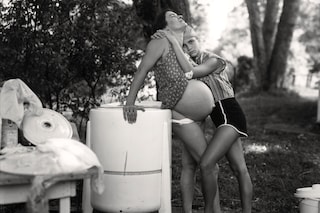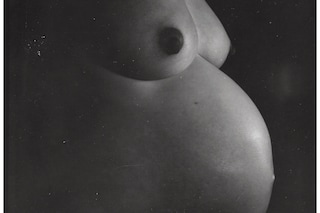From designer babies to artificial wombs, reproduction is being increasingly outsourced to tech – and throwing up urgent ethical questions in the process
This article is part of our Future of Sex season – a series of features investigating the future of sex, relationships, dating, sex work and sex worker rights; tech; taboos; and the next socio-political sexual frontiers.
In 25 years, sex for procreation could be obsolete.
This is according to Hank Greely, a law and bioethics professor at Stanford and author of The End of Sex and The Future of Reproduction. “My firm belief is that people will still have sex for most of the reasons that they do now, but fewer of them will have sex in order to make babies,” he tells Dazed. Instead, Greely hypothesises, people will turn to technology to create children for them.
This may sound far-fetched, but the gap between sex and procreation has been widening for the past 50 years thanks to the rise of fertility drugs, embroynic genetic testing, artificial insemination and in vitro fertilisation (IVF). Over the last ten years in the UK, egg freezing has increased tenfold, from just under 230 cycles in 2009 to almost 2,400 cycles in 2019. IVF birth rates in 2019 were three times higher than in 1991, and the use of egg and sperm donors has risen, too. “Now, maybe three or four per cent of the babies born in the developed world are conceived in some manner other than sexual intercourse, and I think in the future that percentage will go up,” Greely adds.
In the next five to ten years, Greely predicts we will be able to make eggs and sperm by turning skin cells into stem cells, through a process called induced pluripotent stem cells. When scientists figure out how to make this work for humans, infertile and queer couples could have biological babies without needing to go through costly and risky procedures like IVF, donors or surrogates. Single people, meanwhile, could produce ‘uni babies’, using both eggs and sperm grown from their cells.
There’s also the possibility that in the future, babies could be grown in artificial wombs. In 2021, Israeli scientists successfully grew mouse embryos inside glass vials for 11 days, about half the length of a usual mouse pregnancy. In the next 50 years or so, Greely says human babies could also be grown in artificial uteruses kept within ‘bio bags’. “Let it percolate for nine months while you go out drinking every day,” he quips.
Artificial wombs offer an alternative to human surrogacy, and it’s one that journalist Jenny Kleeman, author of Sex Robots & Vegan Meat: Adventures at the Frontier of Birth, Food, Sex & Death, thinks will catch on. Queer people, she suggests, could make up a large part of the target market, as they are already driving demand for human surrogacy as part of the movement for “situational infertility” – which Kleeman describes as a situation where the structure of your romantic partnership means that you can’t ‘naturally’ create a baby together. In those situations, Kleeman says, “you should be entitled to the same benefits as people who are infertile for medical reasons.”
This all sounds great in theory – but how will this work in practice? And what ethical questions does this raise?
In recent years, there have been cases where wealthy parents-to-be have ‘edited’ undesirable mutations out of their child’s genes – and while for now, this is usually done to reduce the likelihood of a child inheriting a hereditary ailment from their parents, this arguably sets a dangerous precedent. Since it’s only going to get cheaper and easier to test for genetic issues, and possibly non-genetic issues, it’s not a leap of the imagination to envisage that the rich could pay for their children to be smarter, faster and stronger, more ‘aesthetically desirable’. Greely agrees that a society where Silicon Valley tech bros create a race of genetically superior babies is possible, and that such genetic ‘enhancement’ could create a Brave New World-esque “caste system”.
For now though, he’s not too worried. We don’t know, for example, which genes would increase intelligence or the ability to be good at things like maths, music or sports, “and it's not clear how much we ever will,” Greely explains. For the most part, scientists are more excited by the potential to eradicate debilitating diseases such as cancer or genetic disorders, rather than create a genetic superrace caste system.
“Now, maybe three or four per cent of the babies born in the developed world are conceived in some manner other than sexual intercourse, and I think in the future that percentage will go up” – Hank Greely
Surrogacy, however, is a more divisive issue. As Dr Rebecca Steinfeld, the senior policy officer for health at Maternity Action, puts it: “surrogates may be vulnerable to exploitation as there is often socioeconomic inequality between surrogate mothers and intended parents. Intended parents tend to be older, wealthier, better educated and employed in higher status jobs than surrogate mothers.”
This certainly tracks with the experience of Kim and Khloe Kardashian who have ‘outsourced’ their pregnancies to surrogates, and in Ukraine, where the majority of the 2,000 babies born through commercial surrogacy are paid for by wealthy foreign couples. While Kim choose to have a surrogate after experiencing a ‘traumatic’ birth where she “almost bled to death”, and the Ukraine women aren’t necessarily coerced into surrogacy, there’s still a power imbalance here thanks to money: wealthy people can afford the option of surrogacy, while poorer people take on the physical risks for a paycheck. So, if ‘mechanical’ surrogacy catches on, in theory, people with uteruses would no longer have to take on the burden of pregnancy and childbirth.
But Kleeman is sceptical. “It could be used to disenfranchise [or] control women, and take away what power they might have,” she says. It’s also a legal and ethical minefield: what happens if the baby in the bag has a heart defect or developmental problem? What happens if there’s a power cut? Who owns the bag if the parents split up? And if things do go wrong – who’s responsible?
Plus, if politicians prioritise the rights of an unborn child matter above all else, then the woman who’s carrying that child becomes more and more of an obstacle. Kleeman argues that “it’s not too much of a conceptual leap to imagine a situation where women are deemed to be behaving too irresponsibly to be pregnant, and they have their pregnancies transferred into these bags.” If the right to an abortion is the right to bodily autonomy, what happens to these rights if pregnancy doesn’t even happen inside your body anymore?
If assisted reproduction becomes more the norm, old-fashioned reproduction may be seen as irresponsible. The burning question, Kleeman says, is whether we will look down on natural-born babies as second-class citizens, “unplanned, or undesigned, and their parents as being risky and chaotic.” Someone has to pay for it, whether that is healthcare companies, governments or the individual, which risks creating what Kleeman calls a ‘fertility apartheid’.
These may feel like hypothetical questions but at this point, these technologies are closer to reality than science fiction. The fertility industry already exploits and will continue to exploit people – so we need to ask in what world these technologies will exist. While technology itself could radically improve access to parenthood, this is equivalent to slapping a plaster over an amputated leg if our society continues to be ableist, classist, racist and capitalist. Tech can’t save us if we don’t save ourselves first.










